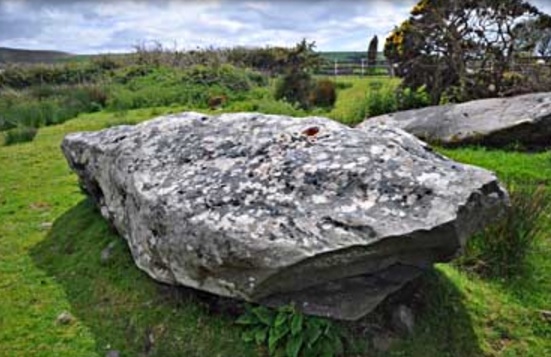Type: Rock Art
Townland: Baile an MhuilinnMilltown

Two prostrate stones lie within 50m of a pair of standing stones (KE043-213----) and within 20m of a tall standing stone (KE043-215----), on gently sloping pastureland on the N side of Dingle Harbour.
The W stone measures 3.25m x 1.4m x .5m thick and bears no markings. The 2nd stone measures 4.2m x 1.25m x .6m thick. On its sloping E face the decoration, with the exception of a single cup-and-circle, is confined to the broad N end.
At least 18 isolated cup-marks are distributed randomly about the decorated area, while 8 cup-and-circles occur along the upper portion of the stone. One of the circles spirals slightly, and most are provided with radial lines which follow the downward slope of the face.
Beneath these is a complex grouping of cup-marks and straight and curved lines, some of the lines joining up to enclose cup-marks. Three further cup-marks occur at the N edge of the WSW face.
Ó Nualláin (1978b, 68) suggests that both these stones may have fallen from an upright position, and Finlay (1973, 9-10) points out that the decoration is likely to have been added subsequent to this as the linear grooves follow the downward slope of the E face.
The inclusion of this site in a list of cist-graves by Simpson and Thawley appears to arise from some confusion with another site (Shee 1972, 233).
The above description is derived from J. Cuppage, ‘Corca Dhuibhne. Dingle Peninsula archaeological survey. Ballyferriter. Oidhreacht Chorca Dhuibhne’ (1986), no. 191.
In certain instances the entries have been revised and updated in the light of recent research.
Helena Zacharias